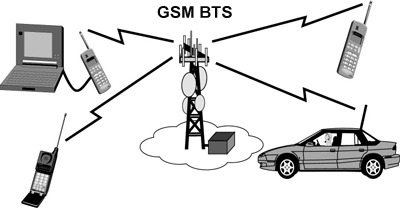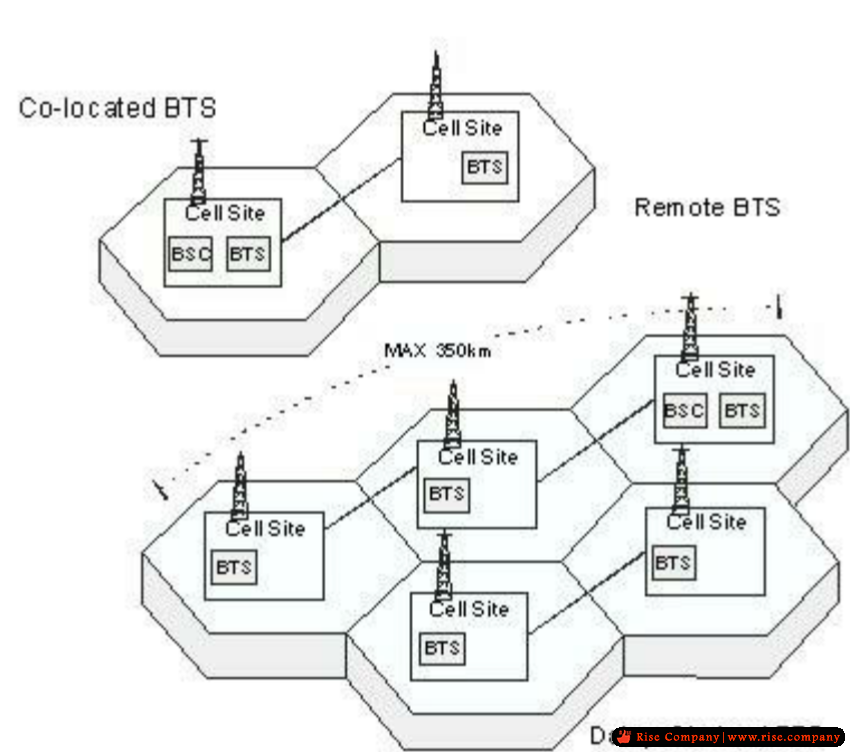مقوي الشبكة Signal Booster محطة الإرسال و الإستقبال BTS
محطة البث القاعدية, Base Transceiver Station
محطة الإرسال و الإستقبال القاعدية بالإنجليزية (Base Transceiver Station ): هو جهاز يسهل الاتصال بين جهاز المستخدم وشبكة اتصال لاسلكي. تكون أجهزة المستخدم عادة أجهزة مثل الهواتف المحمولة أو هواتف الشبكات المغلقة أو حواسب متصلة بشبكة إنترنت لاسلكية. يمكن للشبكة أن تكون أي شبكة اتصال لاسلكية مثل النظام_العالمي_للإتصالات_المتنقلةGSM ، سي_دي_إم_أيهCDMA , دائرة_لاسلكية_مغلقةWLL ، واي-فاي, وايماكس أو أي شبكة عريضة أخرى.
جهاز الـBTS له أسماء أخرى مثل جهاز الإذاعة القاعدية (RBS) وعقدة بوليفيانو (عند توفير خدمة الجيل الثالت3G)، وعقدة بوليفيانو المطورة (عند توفير خدمة الجيل الرابع4G أو تطور طويل الأمد LTE) أو فقط محطة قاعدية (BS).
برغم أن محطة الـBTS تصلح لأي نوع من الاتصالات اللاسكلية، إلا أنها مرتبطة عامة بتقنيات الاتصالات المحمولة مثل GSM وCDMA.
محطة الإرسال والاستقبال الأساسية (BTS) هي قطعة من المعدات التي تسهل الاتصال اللاسلكي بين أجهزة المستخدم (UE) والشبكة. UEs هي أجهزة مثل الهواتف المحمولة (الهواتف) ، هواتف WLL ، أجهزة الكمبيوتر مع اتصال إنترنت لاسلكي. يمكن أن تكون الشبكة من أي من تقنيات الاتصالات اللاسلكية مثل GSM أو CDMA أو الحلقة المحلية اللاسلكية أو Wi-Fi أو WiMAX أو تقنية شبكة واسعة أخرى (WAN).
A base transceiver station (BTS) is a piece of equipment that facilitates wireless communication between user equipment (UE) and a network. UEs are devices like mobile phones (handsets), WLL phones, computers with wireless Internet connectivity. The network can be that of any of the wireless communication technologies like GSM, CDMA, wireless local loop, Wi-Fi, WiMAX or other wide area network (WAN) technology.
BTS is also referred to as the node B (in 3G Networks) or, simply, the Base Station (BS). For discussion of the LTE standard the abbreviation eNB for evolved node B is widely used.
يُشار إلى BTS أيضًا باسم العقدة B (في شبكات 3G) أو ببساطة المحطة الأساسية (BS). لمناقشة معيار LTE ، يستخدم اختصار eNB للعقدة المطورة B على نطاق واسع.
على الرغم من أن المصطلح BTS يمكن أن ينطبق على أي من معايير الاتصالات اللاسلكية ، فإنه يرتبط بشكل عام بتكنولوجيات الاتصالات المتنقلة مثل GSM و CDMA. في هذا الصدد ، تشكل BTS جزءًا من تطورات النظام الفرعي للمحطة القاعدة (BSS) لإدارة النظام. قد تحتوي أيضًا على معدات لتشفير وفك تشفير الاتصالات ، وأدوات فلترة الطيف (مرشحات تمرير النطاق) ، وما إلى ذلك. ويمكن اعتبار الهوائيات أيضًا مكونات BTS بالمعنى العام لأنها تسهل عمل BTS. عادةً ما يكون لمحطة BTS عدة مستقبِلات (TRXs) تتيح لها خدمة عدة ترددات مختلفة وقطاعات مختلفة من الخلية (في حالة المحطات القاعدة القطاعية). يتم التحكم في BTS بواسطة وحدة تحكم محطة أساسية أصلية عبر وظيفة التحكم في المحطة الأساسية (BCF). يتم تطبيق BCF كوحدة منفصلة أو حتى يتم دمجها في TRX في محطات الأساس المدمجة. يوفر BCF اتصال تشغيل وصيانة (O&M) بنظام إدارة الشبكة (NMS) ، ويدير حالات التشغيل لكل TRX ، بالإضافة إلى معالجة البرامج وجمع الإنذارات. يبقى الهيكل الأساسي ووظائف BTS كما هي بغض النظر عن التقنيات اللاسلكية
Though the term BTS can be applicable to any of the wireless communication standards, it is generally associated with mobile communication technologies like GSM and CDMA. In this regard, a BTS forms part of the base station subsystem (BSS) developments for system management. It may also have equipment for encrypting and decrypting communications, spectrum filtering tools (band pass filters), etc. antennas may also be considered as components of BTS in general sense as they facilitate the functioning of BTS. Typically a BTS will have several transceivers (TRXs) which allow it to serve several different frequencies and different sectors of the cell (in the case of sectorised base stations). A BTS is controlled by a parent base station controller via the base station control function (BCF). The BCF is implemented as a discrete unit or even incorporated in a TRX in compact base stations. The BCF provides an operations and maintenance (O&M) connection to the network management system (NMS), and manages operational states of each TRX, as well as software handling and alarm collection. The basic structure and functions of the BTS remains the same regardless of the wireless technologies.
--------------------------------------------------------------
يتكون BTS عادة من
--------------------------------------------------------------
Transceiver (TRX)
Provides transmission and reception of signals. It also does sending and reception of signals to and from higher network entities (like the base station controller in mobile telephony).
Power amplifier (PA)
Amplifies the signal from TRX for transmission through antenna; may be integrated with TRX.
Combiner
Combines feeds from several TRXs so that they could be sent out through a single antenna. Allows for a reduction in the number of antenna used.
Multiplexer
For separating sending and receiving signals to/from antenna. Does sending and receiving signals through the same antenna ports (cables to antenna).
Antenna
This is the structure that the BTS lies underneath; it can be installed as it is or disguised in some way (Concealed cell sites).
Alarm extension system
Collects working status alarms of various units in the BTS and extends them to operations and maintenance (O&M) monitoring stations.
Control function
Controls and manages the various units of BTS, including any software. On-the-spot configurations, status changes, software upgrades, etc. are done through the control function.
Baseband receiver unit (BBxx)
Frequency hopping, signal DSP.
--------------------------------------------------------------
شروط بشأن BTS
--------------------------------------------------------------
تقنيات التنوع Diversity techniques
لتحسين جودة الإشارة المستقبلة ، غالبًا ما يتم استخدام هوائيات استقبال ، موضوعة على مسافة تساوي مضاعف فردي لربع الطول الموجي المقابل. بالنسبة إلى 900 MHz ، يبلغ طول الموجة هذا 33 سم. هذه التقنية ، المعروفة باسم تنوع الهوائي أو تنوع الفضاء ، تتجنب الانقطاع الناجم عن خبو المسير. يمكن تباعد الهوائيات أفقياً أو رأسياً. التباعد الأفقي يتطلب تركيبًا أكثر تعقيدًا ، ولكنه يحقق أداء أفضل.
To improve the quality of the received signal, often two receiving antennas are used, placed at a distance equal to an odd multiple of a quarter of the corresponding wavelength. For 900 MHz, this wavelength is 33 cm. This technique, known as antenna diversity or space diversity, avoids interruption caused by path fading. The antennas can be spaced horizontally or vertically. Horizontal spacing requires more complex installation, but brings better performance.
بخلاف تنوع الهوائي أو الفضاء ، توجد تقنيات تنوع أخرى مثل تنوع التردد / الوقت ، وتنوع مخطط الهوائي ، وتنوع الاستقطاب.
Other than antenna or space diversity, there are other diversity techniques such as frequency/time diversity, antenna pattern diversity, and polarization diversity.
الانقسام يشير إلى تدفق الطاقة داخل منطقة معينة من الخلية ، والمعروفة باسم القطاع. لذلك يمكن اعتبار كل حقل مثل خلية واحدة جديدة.
Splitting refers to the flow of power within a particular area of the cell, known as a sector. Every field can therefore be considered like one new cell.
الهوائيات الاتجاهية تقلل تداخل LoRa (بعيد المدى). إذا لم يتم تقسيمها إلى القطاع ، فسيتم تقديم الخلية بواسطة هوائي متعدد الاتجاهات ، يشع في جميع الاتجاهات. هيكل نموذجي هو trisector ، المعروف أيضًا باسم البرسيم ، حيث يوجد ثلاثة قطاعات تخدمها هوائيات منفصلة. كل قطاع لديه اتجاه منفصل للتتبع ، عادة من 120 درجة فيما يتعلق بتلك المجاورة. يمكن استخدام توجهات أخرى لتناسب الظروف المحلية. كما يتم تنفيذ الخلايا المشطرة. غالبًا ما يتم توجيهها مع الهوائيات التي تخدم قطاعات 180 درجة تفصل بعضها عن بعض ، ولكن مرة أخرى ، توجد اختلافات محلية.
Directional antennas reduce LoRa (Long Range) interference. If not sectorised, the cell will be served by an omnidirectional antenna, which radiates in all directions. A typical structure is the trisector, also known as clover, in which there are three sectors served by separate antennas. Each sector has a separate direction of tracking, typically of 120° with respect to the adjacent ones. Other orientations may be used to suit the local conditions. Bisectored cells are also implemented. These are most often oriented with the antennas serving sectors of 180° separation to one another, but again, local variations do exist.
ملحوظة هذا الموضوع تقرير فقط وخارج خدمات الشركة
المرجع:
https://ar.wikipedia.org/wiki/%D9%85...AF%D9%8A%D8%A9
https://en.wikipedia.org/wiki/Base_transceiver_station
+ إنشاء موضوع جديد
النتائج 1 إلى 1 من 1
-
01-09-2019, 23:56 #1Status
- Offline





- تاريخ التسجيل
- Apr 2014
- الدولة
- Egypt
- المشاركات
- 4,617
 Engineering and Technology
Engineering and Technology
- معدل تقييم المستوى
- 10
 مقوي الشبكة Signal Booster محطة الإرسال و الإستقبال BTS
------------------------------------------------------------------------
مقوي الشبكة Signal Booster محطة الإرسال و الإستقبال BTS
------------------------------------------------------------------------
شركة رايز للهندسة و التكنولوجيا Rise Company for Engineering & Technology
------------------------------------------------------------------------
Web Hosting | Web Designing | E-Marketing
رقم # 1 فى خدمات الشركات Business Services
استضافة مواقع Web Hosting - عمل ايميل شركة Business Emails
تصميم موقع شركة Web Design - تسويق الكترونى على جوجل Google Adwords
www.rise.company | www.rise.company/emails
ملحوظة : جميع خدماتنا مخصصة للشركات فقط وغير متاحة للافراد
وليس لنا اى منتجات او صيانة نهائيا! يرجى الانتباه الى ذلك.
المواضيع المتشابهه
-
مقوي الشبكة Signal Booster فيديو جهاز تقوية اشارة الموبايل GSM Signal Repeater
بواسطة Rise Company في المنتدى قسم مقوي الشبكةمشاركات: 0آخر مشاركة: 20-11-2018, 01:01 -
مقوي الشبكة Signal Booster شرح شامل الـ Antenaa أو الهوائيات
بواسطة Rise Company في المنتدى قسم مقوي الشبكةمشاركات: 0آخر مشاركة: 20-11-2018, 00:17 -
مقوي الشبكة Signal Booster شرح تركيب جهاز Genuinetek
بواسطة Rise Company في المنتدى قسم مقوي الشبكةمشاركات: 0آخر مشاركة: 10-10-2018, 23:46 -
مقوي الشبكة Signal Booster اختبار جودة الاشارة Signal Tester
بواسطة Rise Company في المنتدى قسم مقوي الشبكةمشاركات: 0آخر مشاركة: 10-10-2018, 23:45 -
مقوي الشبكة Signal Booster جينيون تيك genuinetek مقوي شبكات الموبايل
بواسطة Rise Company في المنتدى قسم مقوي الشبكةمشاركات: 0آخر مشاركة: 10-10-2018, 23:30






 رد مع اقتباس
رد مع اقتباس
المفضلات